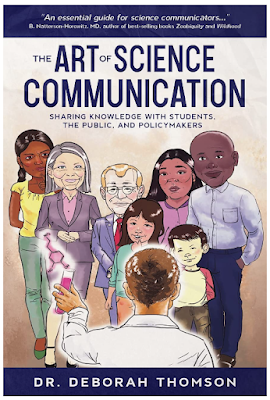Book Review, 15th Edition
Title : The Art of Science Communication: Sharing Knowledge with Students, The Public, and Policymakers
Writer : Dr. Deborah Thomson
Publisher : Thomson Publishing LLC
Year of Published : 2021
Number of pages : 80 pages
This is my first in English Book Review, to close the year of 2023 I would like to share my recent read titlet "The Art of Science Communication" that introduced by my mentor. And this book is quite easy to read, the language is simple whilst none illustration added inside.
To communicate science with public, moreover policy makers is not an easy job. But it is very important for us, scientist, to be able to share our knowledge, support the government, so they can make any policy based on evidence and science. This book answered the need of scientist on how to deliver their findings greatly so they can be heard by the people.
Some people, do not believe in science. It's not a person's fault if they don't believe it. As scientists, we must take the responsibility, as subject matter experts, to value the importance of being relatable. If we are not relatable then our message is less relatable. It is time to remember how life was before we knew our discipline so well. How foreign we must now sound to others outside our world.
First, we should speak with children. If we can't explain our work to a child, then we can't explain our work effectively. Speaking with children strengthen our communication skills, regardless of our ultimate target audience, because children show us exactly how they feel. Beside if we communicate our work to children, they can educate their own families, only if they are interested about what they learned. It will be a domino effect.
Second, being relatable and easy to digest are the key so the audience can understand our information. If there are a lot of info to deliver, then make sure we have a "Take Home Message" that capture the main information we need our participant to remember. In the process of delivering the information, we can use the theory of "telling a story". If there is an "Aha!" moment in our story, don't forget to make that single meaningful point neatly reflect our take-home message. If we have to deliver a controversial topic, be sure to be honest, educating, and leading a conversation (not just a single way convo). Actually, scientist don't have the responsibility to change someone's minds. But, if we have to, then these 4 steps could be used; (1) respect comfort zones, (2) talk about the cost of changing one's mind, (3) address the costs of not changing, (4) end on a high note.
Third, for communicating with policy makers, we need to do some research about their background, their role, how the government works, their position, who to meet, what are their priorities, what's the news, and how to communicate properly. Any wrong act been made when the time to meet the politicians, it will be very difficult for us to make the new opportunity.
Deborah tries to enlighten scientist about the art of communication with various actors from her experiences as a veterinarian who focused on One Health. And I am very grateful to learn from this book as early as I just joined my new division as a young researcher and junior consultant in disaster health management. In the end, what makes us great is practicing. Hope you, scientists wherever you are, could be a good communicator for your discipline and let's make a better world from our work!



Komentar
Posting Komentar